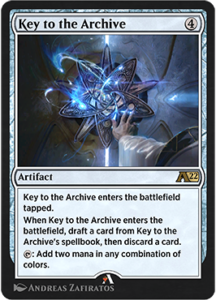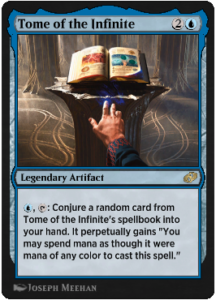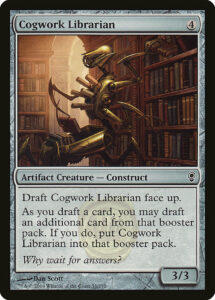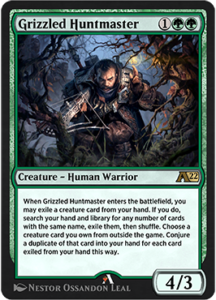Amidst a chilling and once-more isolating winter, Arena Cube has provided solace and fun at a much-needed time. It’s brought me back to the program during the lull between Crimson Vow and Kamigawa: Neon Dynasty.
The latest Arena Cube update included a selection of new, digital-only cards from Alchemy. It’s been fun having an opportunity to finally play with them, seeing I’m not playing Constructed these days. And one card has stood head and shoulders above the rest: Key to the Archive. While it’s been known as a powerhouse in Constructed, it’s been quite the trip getting to play with it in Limited.
The simple stuff
Before getting into the nuances of Key to the Archive‘s spellbook and the draft mechanic, let’s talk about its base rate. A four mana artifact that generates two mana is unplayable in Legacy Cube and underwhelming in most others. Hedron Archive is the best of the bunch despite not providing colored mana. Here, you’ve got a slightly better Firemind’s Vessel that still enters the battlefield tapped. The combination of ramping and fixing is powerful, but it needs a bit more oomph to justify inclusion in a deck.
It often doesn’t take much oomph from a secondary effect to push a card from underpowered to overperformer. Key to the Archive provides two boons: the ability to upgrade a card in your hand, and the ability to discard. That’s pretty similar to looting, and I think a Firemind’s Vessel that looted (digging you past irrelevant ramp and into your payoffs) might just be good enough on its own. I’ve certainly enjoyed the play pattern of discarding a Commit // Memory that I could cast with my accelerated Scholar of the Lost Trove. But Key to the Archive doesn’t draw you a card from your deck, it digs into the Mystical Archive. Which brings us to its spellbook.
Discover something wonderful
Key to the Archive is a delightful callback to Strixhaven’s beloved Mystical Archive. It offers you one of three cards from among Magic’s most iconic spells: Day of Judgment, Approach of the Second Sun, Counterspell, Time Warp, Demonic Tutor, Doom Blade, Lightning Bolt, Claim the Firstborn, Regrowth, Krosan Grip, Despark, Electrolyze, Putrefy, Lightning Helix, and Growth Spiral. It’s a toolbox that can let you run away with a game with a Time Warp, answer any (nonland) card type with Counterspell, Putrefy, or Krosan Grip, or win with a random Claim the Firstborn your control deck would never play (yes, I did steal a Stonecoil Serpent and win with it—and yes, it was awesome).
I really appreciate how despite Key to the Archive having fifteen options, the majority are forms of interaction. Sure, there are the generally less useful whammies in Claim the Firstborn, Growth Spiral, and Approach of the Second Sun, but odds are, you’re going to find something to react to what your opponent is doing. You’re never guaranteed to get a Time Warp (the most powerful spell in the book—Demonic Tutor can’t tutor for banned-in-Historic cards), but there’s a consistency in output that mitigates the inherent variance of drafting from a spellbook. Yet the variety of forms of interaction makes each draft engaging and creates a different texture of gameplay.
It’s nice that Key to the Archive doesn’t muck with the color pie the way that Tome of the Infinite does. Both cards allow a monoblue deck access to Lightning Bolt, but the Archive at least provides the red mana you need to cast it. This does run the risk of stranding the bolt in your hand if your opponent destroys your Archive, but that feels fair. The Tome is right to operate the other way (given that it’s completely random what you get), but it just rubs me the wrong way. And speaking of that,
Let’s talk about Draft
I’ve been enjoying reviewing all the new mechanics introduced last year, but have intentionally avoided discussing those from Alchemy. As mentioned up front, I haven’t been playing Constructed. Accordingly, I hadn’t played with Alchemy’s mechanics and didn’t have enough experience to give them their due. Thanks to Arena Cube, I’ve finally gotten to experience them. And I don’t think drafting from spellbooks is for me, despite how much I enjoyed playing with Key to the Archive.
To be clear, I like digital card creation mechanics. Hearthstone’s Discover is one of my favorite mechanics ever, and Legends of Runeterra’s more restricted version, Invoke, is another favorite. Magic is absolutely right to implement one of the best digital-only mechanics in their digital-only cards. It’s a great idea to leverage Magic’s massive suite of cards to create a twist on Discover that’s both fresh and deeply intertwined with Magic’s history. And it’s been fun to play with.
The problem is I’ve not at all enjoyed playing against Draft cards. It hasn’t been too hard learning the ins and outs of a single card, though with 15 options, that took time. The problem is when I face Faithful Disciple and Cursebound Witch, each of them with their own 15 card spellbooks. The number of cards is small enough that I feel the need to try and remember everything my opponent could have in their hand.
However, that’s a lot to keep track of—I was already not a fan of the amount of text on Strixhaven’s MDFC Deans—and Arena’s UI isn’t designed for me to see all the options at once. If there were many more options, the result would be effectively random, so I wouldn’t bother trying to figure out what my opponent could have; but that would ruin the narrative and mechanical cohesion of the spellbook. And yet if the number were lower, the mechanic would be worse for being too consistent.
While I like so much of the intent behind drafting from a spellbook and understanding why the numbers are what they are, I just haven’t enjoyed playing against them nearly as much as I do similar mechanics in other games. Perhaps it’s because I’m more competitive at Magic and feel the need to optimize, but I think the mechanic itself encourages this fairly painful behavior. Other games don’t show you everything a card could Discover, they just give the Discovering player three options and their opponent no information. That obfuscation prevents players from wasting time and mental energy on difficult and fairly meaningless optimization (unless they’re playing at the highest level). Perhaps this is a growing pain of the mechanic or its visual implementation and it’ll improve with time. Perhaps there simply shouldn’t be that many spellbook cards released at the same time. I’m not sure.
While I had positive experiences playing with Key to the Archive (and then later against it, once I knew its possibility space), my experience overall has made me less interested in playing with more draft/spellbook cards. I love how the mechanic leverages Magic’s history and has this neat little narrative/mechanical cohesion within each spellbook, but the implementation feels insufficiently random, awkwardly presented, and not always immediately obvious what the narrative/mechanical cohesion is. It feels like there were a lot of smart design choices but insufficient playtesting to iron out the kinks. That is not a criticism I levy lightly and one I rarely say about Magic mechanics. Perhaps it’s just not for me, and that’s totally fine. I hope this is a step down the path to even better digital Magic experiences.
Zachary Barash is a New York City-based game designer and the commissioner of Team Draft League. He designs for Kingdom Death: Monster, has a Game Design MFA from the NYU Game Center, and does freelance game design. When the stars align, he streams Magic (but the stars align way less often than he’d like).





